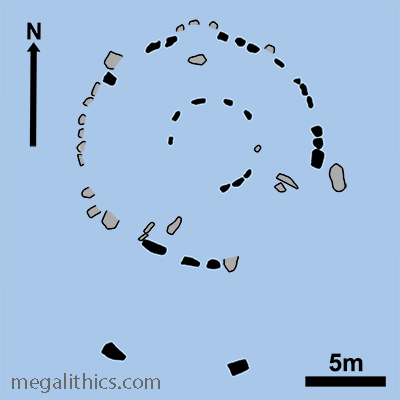 |
| NH 7274 4119 (Pub) | Diameter 14.5m Outer kerb (pub.) 27m Stone Circle (Est) |
| Visited August 1987, June 2010 | Alt.190m (Pub) |
 |
Our visit in 1987 was very brief and unfortunately, as is evident in the above photograph, the field containing the Daviot Ring-Cairn was in full crop when we visited in 2010. Visiting the cairn was obviously impossible without damaging the barley, so we did not approach the landowner for access permission and so have none of our more detailed recording methods ( panoramas, 3D, etc.) that would be typical for this time.
Daviot (INV 28), also known as Mains of Daviot, is a Clava Ring-Cairn in a reasonable state of preservation, it sits in a natural basin which is presently used as arable land, about 5km South of Culloden close to the B861. The river Nairn is only half a kilometre to the SE, but not visible from the cairn due to its recessed situation.

PUBLISHED ACCOUNTS
Cameron
(1)
describes Daviot as "concentric stone circles" in his 1882 work on "Ancient
Circular Dwellings". He comments that Daviot was "used for burial by interment,
but minus a central cairn" which is probably a testament to the amount of
stone robbing that had occurred here. He also mentions that "The centre is said
to have been explored about the year 1820" and "a cist was found containing a
skull and other remains". Daviot must have been an impressive monument then, as
several early accounts give detail of it whilst other ring-cairns are mentioned
by name only. Fraser
(2)
notes the basin-like situation of Daviot and gives diameter measurements for the
rings and an excellent plan of the site. He comments
on the state of preservation then "Of the two inner rings nearly one-third of
the stones are found standing in their places", he also notices that the two
kerb rings are "not concentric, the centre of the inner ring being 2 or 3 feet
northeast of the centre of the intermediate one". Piggot
(3)
merely lists Daviot in the appendix of his paper with no further description.
Henshall includes Daviot in her magnum opus
(4)
and comments that the stones of the central kerb "just project through the
turf", which may explain Thom's omission (see later). The Thoms and
Burl (5)
plan the site in their work of 1980 and provide another brief
description. Puzzlingly, their plan does not show any of the inner kerb stones
that ringed the centre, they do describe "traces of an open central space" but
no mention of stones there. This is odd, as Fraser's plan of 1884 shows a
detailed rendition of the inner kerbs which compares well with more modern
plans.
Tim Phillips includes a photograph of Daviot in his section of Bradley's "A New Investigation of the Clava Cairns" (6), but, apart from stating its location in a natural amphitheatre, gives no further details.
THE CAIRN STRUCTURE
The description here is mainly based on published accounts as we only have our (fairly vague after 33 years!) recollections of our 1987 visit for personal experience of the internal structure.
Most of the outer kerb stones remain and about half are still erect, and the fallen stones seem to be largely in their original locations. Luckily, one of the remaining kerbs is that facing the largest surviving circle stone at the SW, and this kerb would also have been the largest in its circle. The kerb is a massive rectangular block 1.2m tall, dwarfing its neighbours that are only 0.8m and 0.6m high. The builders of this cairn belonged to the Clava tradition and their monuments nearly always emphasise the SW direction, the biggest circle stones and kerbs are found in this quadrant, and in the case of Clava Passage Graves, the entrance passages to their central chambers as well.
At least 8 of the inner kerb stones are still in place but Henshall (4) describes these as only just projecting, they encircle a diameter of about 5.5m. All plans of the site that show the inner curbs, put their circle centre to the NE of the outer kerb circle centre. Several other Clava ring-cairns show slight non-concentricity of the inner space, but many of these have scant remains of the inner stones so this may be a result of interpretation, at Daviot however, there are ample remaining stones to confirm the large offset seen there.
The cairn fill has almost all been robbed away, the interior is said to be slightly higher than the surrounding ground, but it is not clear if this is due to fill remnants.
Only two stones of the stone circle that once surrounded Daviot survive, and both are erect. The stone at the South is 1.3m tall and the SW stone is a 2.5m high triangular slab. When the circle was intact, the SW emphasis would have been obvious, and further reinforced by the massive outer kerb stone facing the tallest monolith. Extrapolating a true concentric circle through the two remaining stones gives a diameter of 27m, and using the spacing of the two surviving stones suggests an original stone count of 11, a common number for cairns of this type. As the cairn has not been excavated in modern times, the true circle diameter and stone count is unknown.
1.
Cameron, D.,
Proceedings of the Society of Antiquaries of
Scotland, 16, p.293,1882.
2. Fraser, J.,
Proceedings of the Society of Antiquaries of
Scotland, 18, p.328-61,1884.
3.
Piggott, S., Proceedings of the Society of Antiquaries of
Scotland, 88, p.173-207,1956.
4.
Henshall, A. S.,
The Chambered Cairns of Scotland,
p.374, Edinburgh University Press, 1963,
Edinburgh.
5.
Thom, A., Thom, A. S. and Burl, A., Megalithic
Rings, B.A.R. British Series, 81, 1980, Oxford.
6.
Bradley, R., "The Good Stones, A New Investigation of the
Clava Cairns", Society of Antiquaries of Scotland
Monograph Series Number 17, p177, Edinburgh 2000.